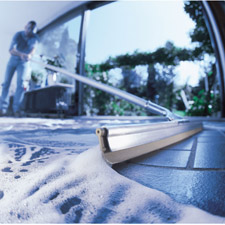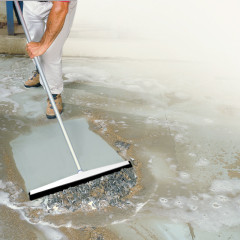How To Clean Concrete Floors After Flood
How to Clean upward After a Inundation
 A flood is a devastating disaster in itself, but if left untreated, can pb to even further impairment. Standing water and wet floors can quickly become a breeding basis for bacteria and mold if not cleaned up effectively.
A flood is a devastating disaster in itself, but if left untreated, can pb to even further impairment. Standing water and wet floors can quickly become a breeding basis for bacteria and mold if not cleaned up effectively.
Overflowing water may also contain sewage from overflowed or outburst pipes, making it even more critical that you take the proper steps in protecting yourself and your family during the cleanup process.
Flood Cleanup – Before You First:
- Proceed children and pets out of the area until flood cleanup is consummate and you've determined it's safety for them to enter the afflicted area.
- E'er wear rubber or other not-porous boots, gloves, and middle protection when working in the area.
Walk through the afflicted area to identify which items are salvageable and which are not.
- While difficult to office with personal belongings, if they can't exist washed and disinfected you will need to remove and destroy them.
- Mutual items that can't be disinfected include mattresses, pillows, carpeting, rugs, books, cosmetics, infant toys, and upholstered piece of furniture.
- Drywall and insulation also can't exist disinfected subsequently they come up in contact with sewage or flood waters and should be removed and destroyed.
Finding the Correct Tool 
To remove the h2o and debris from the floor, Unger Professional floor squeegees are ideal for removing large volumes of water or debris and tin exist used on a diverseness of surfaces such equally asphalt, tile, concrete, and linoleum. They are commonly used for both residential and commercial tasks when there is a lot of surface area to clean and dry.
The type of squeegee to use for h2o removal depends on the type of flooring.
Uneven flooring, like tile and asphalt: A foam squeegee is best because the soft foam rubber blade can adjust to the cleaning surface.
Smooth floor, like concrete and asphalt: A squeegee with a safe blade is the best tool for the task.
Begin the H2o Removal Process
Once you take the right floor duster, you tin brainstorm the water removal procedure.
- To finer motion water and debris, pull (don't push) the duster for best results.
- Begin at the edge, moving the liquid and debris towards a drain.
- If there isn't a drain within the area, move the liquid and debris into a pool so that you tin then apply a saucepan and pan for removal.
- Continually tap squeegee to remove excess liquid or dirt.
Once the water has been removed:
- Launder the flooring surface with soap and warm, clean water.
- The floor squeegee can go on to exist used for this process.
- Next, sanitize the surface with household bleach.
- Mix one loving cup of bleach with 5 gallons of h2o in a big saucepan.
- Use the flooring squeegee to spread the bleach mixture on the floor to sanitize the surface.
- Allow the bleach to sanitize the floor, do not rinse with water, just allow information technology air dry.
If there was mold growth on the floor surface:
- You will need to use a stronger bleach concoction by mixing 1 cup of bleach for every i gallon of h2o in a saucepan.
- Wash the floor surface with the bleach mixture.
- Use a heavy duty brush, such as the Unger Professional HydroPower Bi-Level Scrub Brush or Unger Professional person Outdoor Scrub Brush to scrub the floor clean.
- Then, rinse the surface with clean water and let to air dry.
Next, make clean and sanitize all other hard surfaces with hot water and soap:
- Laundry or dish soap are suitable for basic cleaning but to sanitize, bleach is necessary.
- After yous have cleaned with the soap, rinse the surface with make clean water.
- So, add ane cup of bleach for every 1 gallon of clean h2o in a bucket.
- Sanitize the surface with this concoction and allow to air dry.
- Food surfaces that may have come into contact with the inundation water should follow the same cleanup process.
- Simply but use i teaspoon of bleach for every gallon of bleach.
If you have a dehumidifier, this is platonic in helping with the drying process and preventing mold growth. Yous tin besides employ fans or air conditioner units to continue the air moving inside the affected area.
One time the flood cleanup is complete, launder your hands thoroughly with soap and warm water. You should also wash all apparel that were worn during the alluvion cleanup in hot water and detergent. Wash these clothes carve up from the rest of your laundry. Nonetheless, before using your washing automobile, have your onsite waste-water organization professionally inspected and serviced.
For more than cleaning tips from the professionals, visit our Resource folio.
Source: https://ungerconsumer.com/professional-cleaning-tips/how-to-clean-up-after-a-flood/
Posted by: parkersookinium.blogspot.com


0 Response to "How To Clean Concrete Floors After Flood"
Post a Comment